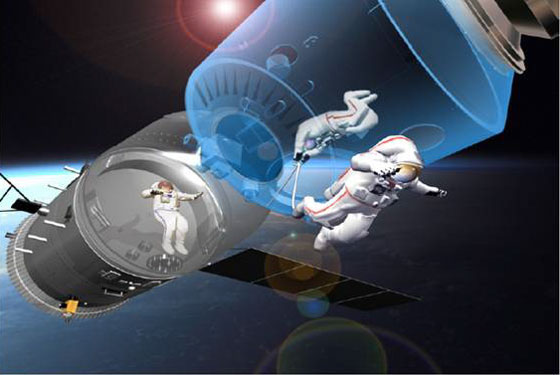Chinese Space Officials Meeting with NASA Today

NASA is hosting Earth and space science working group meetings with officials from the China National Space Administration (CNSA) in Washington, D.C., SPACE.com has learned.
The talks, today and tomorrow, are a follow- up to NASA's most recent meetings with CNSA representatives held June 30 to July 1in Beijing. That meeting brought together CNSA officials and other interested Chinese agencies with a NASA delegation made up of representatives from the space agency's Office of External Relations and the Science Mission Directorate.
On that occasion, the discussions represented the first joint meeting of the Earth and space science working groups that CNSA proposed to NASA in September 2006, during NASA Chief Mike Griffin's trip to China.
Also this month, NASA specialists are traveling to China to attend the Pan Oceanic Remote Sensing Conference in Guangzhou, Michael Braukus, a NASA Public Affairs Officer told SPACE.com.
Meanwhile, China continues to broaden its menu of space activities.
A few days ago, China lofted another of its remote sensing spacecraft in the Yaogan series. Its mission, according to Chinese news agencies, is to carry out land resource surveys, estimate crop yields, as well as assist in disaster prevention and relief efforts.
China is also pressing forward on its human space exploration plans.
Get the Space.com Newsletter
Breaking space news, the latest updates on rocket launches, skywatching events and more!
Shortly after that country's late September completion of a three-Taikonaut Shenzhou-7 mission -- including their first space walk -- Wang Zhaoyao, deputy head of China's manned space program office underscored China's ambitions for a human trek to the moon. "We see a manned lunar landing as both a very challenging and tactical field in global hi-tech," Wang said. "We deem it necessary for our country to do something in this field."
Next up in taikonaut takeoffs is a multiple volley of Shenzhou spacecraft, according to Qi Faren, a leading Chinese space official.
Qi told the Shanghai-based Oriental Morning Post in September that in 2010 unpiloted Shenzhou 8 and 9 spacecraft -- loaded with lab equipment -- would be sent spaceward and linked together in orbit. If that linkup was successful, a piloted Shenzhou 10 mission would be flown to the docked vehicles.
Qi said that creating this small laboratory in orbit would be a bridge to China's intent to build a larger space station in 2020.
- Video - Direct from the Moon
- China's First Spacewalk: A Prelude of Things to Come
- The Future of Flight
Leonard David has been reporting on the space industry for more than four decades. He is past editor-in-chief of the National Space Society's Ad Astra and Space World magazines and has written for SPACE.com since 1999.
Join our Space Forums to keep talking space on the latest missions, night sky and more! And if you have a news tip, correction or comment, let us know at: community@space.com.

Leonard David is an award-winning space journalist who has been reporting on space activities for more than 50 years. Currently writing as Space.com's Space Insider Columnist among his other projects, Leonard has authored numerous books on space exploration, Mars missions and more, with his latest being "Moon Rush: The New Space Race" published in 2019 by National Geographic. He also wrote "Mars: Our Future on the Red Planet" released in 2016 by National Geographic. Leonard has served as a correspondent for SpaceNews, Scientific American and Aerospace America for the AIAA. He has received many awards, including the first Ordway Award for Sustained Excellence in Spaceflight History in 2015 at the AAS Wernher von Braun Memorial Symposium. You can find out Leonard's latest project at his website and on Twitter.










